|

The Mulch
Katie’s Cracking Choices…
I asked Katie Long of Katie’s Greenhouse in Brockenhurst, Hampshire (01590 623300), to list her top three perennials for reliability, impact and their easy-going nature. Katie’s advice is to plant en masse for best effect and to deadhead regularly to prolong the flowering period…
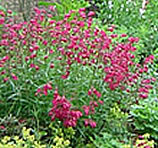 |
“My first choice would have to be Penstemons, available in so many beautiful colours, flowering from early summer to the first severe frosts. The smaller the leaves, the hardier they seem to be. The deep rose, P. ‘Andenken an Friedrich Hahn’, is a particular favourite of mine.” |
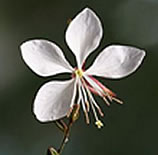 |
“My second choice would be Gaura lindheimeri, an airy fountain of tiny, dainty butterfly-like flowers on long stems. With varieties available in whites and pinks, it is a prolific and long-flowering perennial. G. ‘Whirling Butterflies’ is a spectacular tall, elegant variety.” |
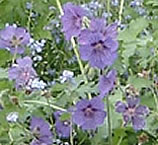 |
“Hardy geraniums would be another staple choice. Some are almost evergreen (eg. G. reynardii), and others have wonderful, reddish-tinted leaves in autumn (eg. G. macrorrhizum). G. pratense, a native species, is a firm favourite, with abundant blue flowers all summer.” |
Photos supplied by Katie Long |
Katie grows a wide range of plants, particularly tropical, exotic and unusual specimens and can grow plants to order from seed, if required.
First Impressions…
I’ve always been impressed by the generosity of gardeners when it comes to sharing tips, knacks and insights (and very often seeds and plants), without a hint of competitiveness around successes or schadenfreude over others’ dismal results or failures.
In fact, in my experience, a gaggle of gardeners (and garden designers) is always a light-hearted, warm and often forthright gathering, full of fascinating observations, opinions and news from the ever-growing world of horticulture.
With this in mind, I have started to write up my personal thoughts about some of the many gardens I have visited in recent years. I’ve included photos and contact details and directions to the gardens, in case you wanted to visit the garden yourselves (to compare your impressions with mine, perhaps). Just remember to check opening times before you set off!
The first set is now available to read or download on the website in pdf format and more will follow over the summer.
www.thegrowingcompany.co.uk/gardens2visit
Where On Earth..?
I like to think a garden can be a ‘magic carpet’: by choosing the right colours, plants and features, it can be easily and inexpensively transformed into a passable version of your favourite part of the world, or made to evoke a particular culture or tradition that you admire.
In the selection of gardens below, the essence of a particular corner of the world has been recreated through attention to detail at the design stage and the selection of appropriate materials, focal points and planting themes.
 |
< A Rich Warmth
The wonderful old wooden beams and deep overhang of this shady patio in Eastern France gave this corner of the farmhouse a lovely, antiquated feel. The bold blue wall works well with the terracotta tile pattern and sets off the dark handmade wooden furniture nicely. Jenni Tarry transformed this cosy space into a wonderful, warm reflection of one of her favourite places in the world, Morocco. |
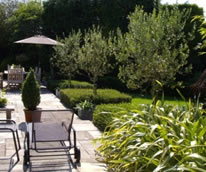 |
< A Charming Study
A series of neatly clipped dark green hedge cubes (Lonicera pileata) set off the silvery green canopies of three olive trees (Olea europea) alongside a pale sandstone patio, echoing the style found in many gardens of Le Midi, in southern France. A profusion of limey-green Phormiums help to make this whole composition a charming study of shades of green in Hampshire. |
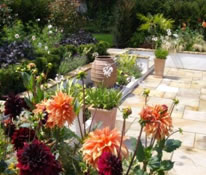 |
< A Vibrant Splash
Dahlias, Cosmos, Phormium, Stipa tenuissima, Agapanthus, Lavender and Trachycarpus fortunei exploded from these poolside beds last summer, providing a vibrant splash of Mexican exuberance, panache and vivacity in this Hampshire garden. Crisply rendered and painted geometric retaining walls help to contain and accentuate the explosive qualities of this brash and warm planting scheme. |
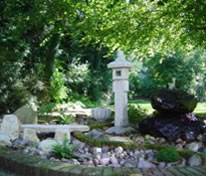 |
< A Captured Moment
In this Japanese Zen composition, in a garden in the New Forest, everything has been pared back to its essential expression – tall, upright features contrast with low, horizontal objects. Planting is minimal, low growing and evergreen and balances the still composition of stone bridge, lantern and natural boulder water feature. This is a moment forever suspended in time. |
The Red Queen of Autumn…
Last autumn the hedgerows and woodlands were lit up by a bounty of berries dripping from the boughs of Rowan trees. Cheery baubles of orange, scarlet and pillar box red enlivened many local scenes as the backdrop turned slowly to a greeny-grey, wintry brown.
In Old Norse, ‘Rowan’ derives from the verb ‘to redden’, which is what this tree does through its leaves and edible berries in spectacular fashion every autumn.
At Garreg Gron, unusually for a mountain-side garden, we didn’t have any Rowan trees so this winter we remedied the situation and planted Sorbus Commixta, S. Aucuparia (Mountain Ash) and S. Joseph Rock for their contrasting forms and autumn berry and leaf colours.
There’s an old tradition to plant a Rowan near the door of a house (and to carry a Rowan twig or cross with you) to protect from witchcraft. This may have something to do with the bright red colour of the berries (it foils enchantment!) and the presence of a tiny pentagram pattern – a symbol for protection – at the base of the berry, opposite the stalk. For more information on the folklore and myths of trees, including Rowans, go to: www.treesforlife.org.uk.
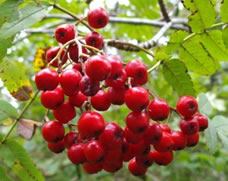 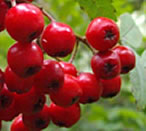 < Absorbing Sorbus < Absorbing Sorbus
The five star pentagram shape, an ancient symbol for protection against evil spirits, can be clearly seen at the base of each berry
Long and Winding Road
A couple of years ago, I worked with a number of groups and individuals across Southampton to create labyrinths in public parks and gardens. Labyrinths are deceptively simple patterns that you follow from the entry point on the perimeter towards the centre. Labyrinths differ from mazes in that you can’t get lost – there’s just one path, although it can twist and turn and double back many times.
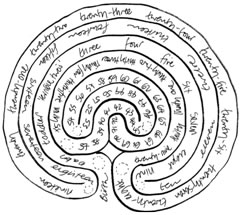
< Walk for Life
Is the labyrinth path a metaphor for life?
During one of these walks, I wondered if the labyrinth might be a timeline of life. Is it possible to overlay the years of our typical lives over the twists and turns of the labyrinth, to understand ourselves and life, better? www.thegrowingcompany.co.uk/labyrinth.html
Cuttings…
Ain’t No Mountain High Enough…
A regular gardening job now brings me right under the imposing shark’s-tooth form of Mount Snowdon. On a clear day, you can see the new café at the summit – the long horizontal building looks like a visor’s slit across the peak, giving the brooding form an unblinking, monocular vision.
Back To School
I’ve started working in a hillside garden that used to be in the NGS Yellow Book Scheme, Yr Hen Ysgoldy (The Old Schoolhouse). I really enjoy the peaceful, secluded location and the three babbling brooks tumbling through the garden.
Everybody Needs Good Neighbours
Just down the road from here is a horticultural therapy charity, Cultivations. It aims to help people improve their health and sense of wellbeing through interactions with nature in all its forms. www.cultivations.co.uk
Sign of the Tines
The coldest winter in Wales for more than 30 years interrupted many of my plans on the garden redesign and renovation front here at Garreg Gron.
Nevertheless, I have managed to tame the rampant autumn raspberries on the second terrace (they are corralled behind a scaffolding plank at one end now) and culled the dormant crocosmias by about 90%.
The rambling roses and fuchsias have been pruned, the spreading Geranium maccrorhizum trimmed back, releasing a magical musky aroma in the process, and raised beds have been prepared for the new growing season. Loose rock lies just below the soil surface all over the garden and I have gone through two forks since November.
In hindsight, I’m glad I didn’t have a chance to tackle too many parts of the garden last year or I wouldn’t have appreciated the hundreds of bulbs that had been planted by previous owners all around the garden.
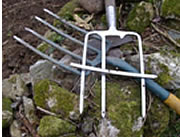 |
< No Fork Left
Topsoil is thin in this mountain-side garden with lots of stones and rocks buried just under the surface, snagging my forks as I dug |
Boxing Clever >
Although terraced many years ago, I am building more raised beds in the vegetable plot this spring |
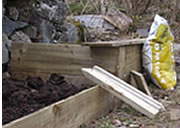 |
|



